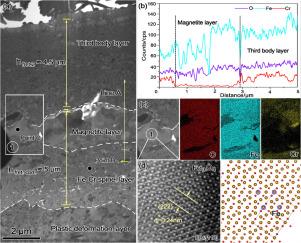Insight into the fretting corrosion behavior of 316L steel in liquid lead-bismuth eutectic at 500°C
IF 2.8
2区 工程技术
Q3 MATERIALS SCIENCE, MULTIDISCIPLINARY
引用次数: 0
Abstract
Due to flow induced vibration caused by coolant circulation, fretting corrosion inevitably occurs between fuel cladding, heat exchanger tubes and their holders in Gen IV lead-bismuth eutectic (LBE) cooled nuclear reactors. In the current work, fretting corrosion behavior of 316 L steel in oxygen-saturated LBE at 500 °C has been investigated. It is shown that within the gross slip regime, the microstructure under fretting interface presents a stratified structure, composed of third body layer, oxide scales and plastic deformation layer. At the early stage of fretting corrosion, the dominant damage mechanism is fretting wear, showing that the thickness of third body layer is much larger than that of oxide scale. As fretting time increases, the dominant damage mechanism is gradually changed to LBE corrosion and fretting wear together, as the visible oxide scale is formed next to the third body layer. Moreover, the growth rate of oxide scales under fretting interface is accelerated by over an order of magnitude compared to that when 316 L steel exposed to LBE directly. In particular, after 60 h exposure, the thicknesses of oxide scale related to the worn and unworn regions are ∼4.5 μm and ∼0.2 μm, respectively. The occurrence of such phenomenon is thought to be ascribed to the severe plastic deformation under fretting contact interface, since the crystal defects served as perfectional nano-channels can promote the diffusivity of oxygen atoms. In addition, the acceleration diffusivities of oxygen atoms caused by the local high contact stress may also be responsible for this matter.

洞察 316L 钢在 500°C 铅铋共晶液中的烧蚀行为
在第四代铅铋共晶(LBE)冷却核反应堆中,由于冷却剂循环引起的流动诱导振动,燃料包壳、热交换器管及其支架之间不可避免地会发生摩擦腐蚀。在当前的工作中,研究了 316 L 钢在 500 °C 氧饱和 LBE 中的摩擦腐蚀行为。研究表明,在大滑移体系中,烧蚀界面下的微观结构呈现分层结构,由第三体层、氧化鳞片和塑性变形层组成。在烧蚀的早期阶段,主要的破坏机制是烧蚀磨损,这表明第三体层的厚度远大于氧化鳞片的厚度。随着烧蚀时间的增加,主要的破坏机制逐渐转变为 LBE 腐蚀和烧蚀磨损共同作用,因为在第三体层旁边形成了可见的氧化鳞片。此外,与直接暴露于 LBE 的 316 L 钢相比,氧化物鳞片在摩擦界面下的生长速度加快了一个数量级以上。特别是在暴露 60 小时后,磨损区和未磨损区相关的氧化鳞片厚度分别为 ∼4.5 μm 和 ∼0.2 μm。这种现象的出现被认为是由于在摩擦接触界面下发生了严重的塑性变形,因为晶体缺陷作为完美的纳米通道可以促进氧原子的扩散。此外,局部高接触应力导致的氧原子加速扩散也可能是造成这种现象的原因。
本文章由计算机程序翻译,如有差异,请以英文原文为准。
求助全文
约1分钟内获得全文
求助全文
来源期刊

Journal of Nuclear Materials
工程技术-材料科学:综合
CiteScore
5.70
自引率
25.80%
发文量
601
审稿时长
63 days
期刊介绍:
The Journal of Nuclear Materials publishes high quality papers in materials research for nuclear applications, primarily fission reactors, fusion reactors, and similar environments including radiation areas of charged particle accelerators. Both original research and critical review papers covering experimental, theoretical, and computational aspects of either fundamental or applied nature are welcome.
The breadth of the field is such that a wide range of processes and properties in the field of materials science and engineering is of interest to the readership, spanning atom-scale processes, microstructures, thermodynamics, mechanical properties, physical properties, and corrosion, for example.
Topics covered by JNM
Fission reactor materials, including fuels, cladding, core structures, pressure vessels, coolant interactions with materials, moderator and control components, fission product behavior.
Materials aspects of the entire fuel cycle.
Materials aspects of the actinides and their compounds.
Performance of nuclear waste materials; materials aspects of the immobilization of wastes.
Fusion reactor materials, including first walls, blankets, insulators and magnets.
Neutron and charged particle radiation effects in materials, including defects, transmutations, microstructures, phase changes and macroscopic properties.
Interaction of plasmas, ion beams, electron beams and electromagnetic radiation with materials relevant to nuclear systems.
 求助内容:
求助内容: 应助结果提醒方式:
应助结果提醒方式:


